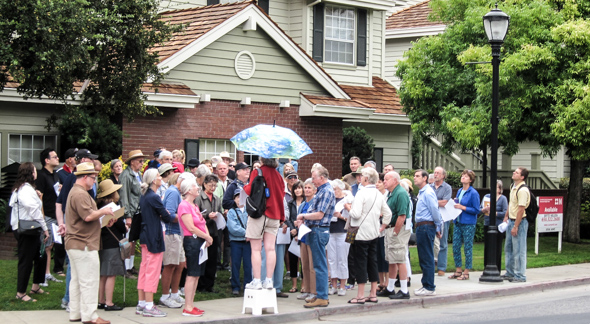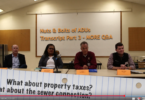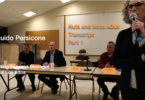After a 10-day trial with 22 witnesses during January, the presiding judge in the investor’s lawsuit against 40 Main Street Offices LLC has made an award that could exceed $2 million. The Sorensens lost another one in their long-running struggle with their neighbor Ron Packard.
In 2012 the Los Altos City Council rejected the Sorensens’ design plan for a three-story office building at 40 Main in downtown for these stated reasons: it exceeded height limits, it did not meet parking requirements, and its pedestrian paseo was not a sufficient community benefit. As suggested in the City staff report, the planning application review process for 40 Main — nearing its 24th month — was terminated by Council. [This Council action overturned the decision of the Planning Commission, which had conditionally approved the plan. The Council reorganized and reshuffled members of that commission.]
During those years, the Sorensens’ troubles in getting project approval were a cause celebre of the downtown vibrancy advocates. They were portrayed as victims of cronyism in City Hall and especially of Mayor Ron Packard who owned the office building at 4 Main Street right next door to the Sorensen project. However, to downtown preservationists, the Sorensen project was a bete noir that would create a terrible precedent for excessive height/ bulk and parking shortages up and down Main & State Streets. The Sorensens would be ruining the “village character.”

Former Council Member Ron Packard has been portrayed as the bad guy, the Sorensens as his innocent victims.
Soon after the City Council emphatically nixed the project in 2012, some of the investors in Ted and Gerry Sorensens’ 40 Main Street Offices, LLC real investment company began to consider steps to eventually bring a lawsuit claiming mismanagement and fraud. They wanted their money back with damages. The “Claimants” considered hiring the Sorensens’ neighbor at 4 Main street — then City Mayor Ron Packard — as their attorney; in the end Packard has been active in the case, but in the role of legal consultant to the lead attorney. Packard was hired for his knowledge of city zoning and process.

Judge Kumar will return the investors original investment plus interest. At 10% a year, this table could be a worst case outcome for the Sorensens LLC.
Now after three years of litigation and a ten-day trial, the artibrator, retired Judge Jack Komar, has found “negligent misrepresention of facts” but no fraud. The award to the claimants — who are 40% of the investors — will be their original investment plus interest; legal fees could be added in during proceedings in March. The original investment by the claimants was $1,136,000. The legal rate of interest based on investment contract is 10% per Civil Code §3289. If that rate applies and if interest is started from 2008, the time of the original investment, then the entire award/judgment could amount to around $2,500,000 after interest but before attorney fees and costs. After attorney fees and costs, the total judgment could be closer to $3,000,000. According to Mr. Packard the award is binding and will “become a non-appealable enforceable judgment within days.” [UPDATE March 7 – A reader informed me that as an arbitrator Judge Komar issued a “final award.” That is then taken to superior court in the next month, where a the superior court makes it a judgment. At that court, Sorensens can challenge the final award, but it is nearly impossible to change.
Nature of the Sorensens “Negligent Misrepresentation”
The judge found that the investors were induced to participate because of a prospectus that touted 3 development plans with ROIs of ~100% to 167%. There were two 3-story options and one 2-story option in the prospectus. The investors were told it was possible to build 20 stalls of underground parking on the site.

The Prospectus of March 2007 says 20 underground stalls are feasible on the site, when they are infeasible. Prospectus said there was a profitable 2-two approach, but that was not pursued by the Sorensen LLC.
Lalahpolitico: It is true that back in 2012 some zoning had recently been upzoned. On most of the First Street CD3/CR zone 3 stories and 45 feet were approved there…but Main Street is part of the “downtown core” and is NOT in that zone. It is true that some recent 2012 projects outside of the “downtown core” had received some developer concessions – arguably height and parking — in consideration of community benefit. It is true the the 2012 Enchante Hotel project did not include parking… because the developer had successfully argued its guests would not typically have cars and those that did have cars would park at night and other non-peak hours.

As with most small downtown parcels, there is no way to build underground parking at 40 Main (on the left). Judge Kumar said the Sorensens’ prospectus misrepresented the facts to induce investment.
In 2011 as the Sorensens began formal design they discovered there was no way to economically build any underground parking on their small parcel, much the less 20 stalls. Question: So was there a chance in 2011 and 2012 that the Sorensens might be able to get a 3-story through planning and talk their way out of needing 20 parking spaces in spite of the restrictive zoning of the downtown core? Lalahpolitico: Not much of a chance. A 3-story building over 35 feet to the roofdeck on Main Street was pie-in-the-sky given zoning in the core. There was no Parking-in-Lieu Program then or now, and no way to pay for the project’s missing parking. As the Judge Komar put it, the Sorensens should have known…or should have checked the facts as to the zoning for their land. To not do so, and to use factoids in the prospectus was “negligent misrepresentation.”
Why not the 2-story plan with 100% ROI
So why did the Sorensens not submit a new planning application for a 2-story, which according to the LLC prospectus was a money-making option? Unknown. Ron Packard says that from the first time the Sorensens introduced him and his brother Von to their 3-story, he expressed his opposition and tried to steer them to a conforming two-story. Later, as the Sorensens persisted with their 3-story, Packard asked LATC editor Bruce Barton to attend a meeting with the Sorensens, where the Packards tried again to promote a 2-story to no avail.

Jerry Sorensen. The managers of the LLC, presumably Jerry and his brother Ted Sorensen, may have manipulated 80% of their investors into signing away rights with an Amendment to the Original Operating Agreement. Judge Kumar rejected the amendments in making his judgment.
Railroading Amendments to the LLC Operating Agreement
As early as 2012 some of the investors were getting nervous and suspicious. Apparently the Sorensen LLC was not keeping up with stipulated annual reports to investors and did not want to “open the books” for inspection by an investor who asked as was his right under the Operating Agreement.
Suddenly one day, 80% of investors…not all of them…received an urgent notice that they MUST sign and return an amendment to the operating agreement by that evening…OR ELSE risk losing their entire investment.
The amendments had the effect of creating monetary penalties for any traitors who might try to pull-out of the investment agreement and had the effect of reducing investor rights to recover their investment.
In his deliberations, Judge Komar decided the amendments were invalid and the Claimants could not be held to them. Instead the the terms of the original operating agreement would be applied. Hence, the Award of full return of the original investment with interest. Lalahpolitico: This manipulation of the investors is very unsavory.
The Worst Neighbor Relations in Town!
Ted Sorensen is an attorney and so are Ron and Von Packard. Those parties now have a long history of complaints and legal actions against each other or against related parties they have represented. Lalahpolitico does not doubt that Mr. Packard was always very, very careful to to adhere to the Brown Act and recuse himself from Council decisions and to NOT discuss the Sorensen plans with City staff, City commissioners or other City Council. There is no evidence that he did. Nonetheless, some vibrancy advocates feel “strings were pulled” for favorites…and then not pulled for the unfavored.
List of Highlights of mutual Legal Aggression
Packard – June 2012, EIR letter to City Council saying the City should have done an Environmental Impact Report about the Sorensen 3-story plan… Outcome: no action as the Sorensen project was killed 4-0 by Council, with Packard recused.
Sorensen – Complaints to California Fair Political Practices Commission , FPPC twice. Outcome: First the FPPC reviewed but found no evidence of Packard wrong-doing; Second one, the FPPC just dismissed the complaint.
Sorensen- Complaint to Santa Clara District Attoney’s Office re: Packard. Outcome: The DA dropped the investigation against Packard.
Packard – His group – the Friends of Los Altos – flagged Brown Act violations by Council Member Jean Mordo in the Ad Hoc Parking Committee in 2015. Jerry Sorensen was an active attendee and video taped 20 of the meetings. Mordo urged attendees as well as members to contribute content. Sorensens apparently had input into the report section about the Parking In Lieu Program — the report advocates Plaza restripping to increase the supply of stalls…before worrying about how to finance a parking structure. This is the 2012 restripping idea the Sorensens pitched to Council when they were trying to get their 40 Main Office Building plan approved. At that time they offered to pay $300,000 for redoing Plaza 10. In the 2015-16 Parking Report, the authors recommend restripping one plaza a year, paying it out of City maintenance budget.

The Sorensens were betting that the City would start a Parking in Lieu Program with Plaza restriping. In that way, their project could meet the parking requirements
Outcome: A San Francisco attorney who is an expert in such matters was hired by the City to do an investigation. The City adopted a resolution saying there was a Brown Act violation. Later the City hired a consultant for few thousand dollars…not to accuracy check the content of the Parking Committee Report…but just to read it and affirm that the findings were not off-the-wall. The City is including the “tainted” report as one of the inputs to the upcoming “downtown visioning” process.
Sorensen – 2017 accusations during the Judge Kumar arbitration. Outcome: The arbitrating judge disregarded the accusations and found FOR the Claimants, making an Award – return of orginal investment plus interest for years.
Sorensen – 2017 files a new lawsuit… apparently because Packard advocated at the City Council Meeting that the Council not accept the Parking Committee Report but throw it out. Lalahpolitco: Following Packards remarks, two vibrancy advocates, I believe it was Mark Rogge and Bill Matson, as well as Council Member Mordo, each made very impassioned, accusatory remarks after Packard spoke. It was not a shining moment for those three individuals.
Packard – 2017 , in response to the latest lawsuit above. Packard files an anti-SLAPP motion. [action against repetitive, and frivolous lawsuits]. Outcome: the Sorensens did not try to provide substantiation, but instead dismissed their lawsuit.

Here are some of the City Fathers in the early 1950s. One of their first actions after incorporation was to hire a police department. The offices were downtown. Were they renting? Credit: Los Altos History Museum FACES exhibition.
LosAltosPolitico Bottomline
re Ron
Ron Packard was elected to Council in part because he would preserve “village character” cherished by many City residents/voters. Yet he also proved responsive to downtown property owners and business complaints that there was a need for more vibrancy and fewer shop vacancies…especially after the 2008 great recession.
He and the rest of that Council were willing to upzone outer First Street to 45 feet to stimulate some redevelopment, but never the downtown core [except for some technicalities.] And apparently he and the rest of that Council [ Carpenter, Casas, Fishpaw and Satterlee] got too far ahead of a lot of the community with that First Street change; those zoning changes have just been rolled back.
Packard thought vibrancy in the downtown core might be improved if banks were banned; they don’t have shop windows filled with visual interest for pedestrians. The community did not agree with him; he cheerfully accepted the response and dropped his Ban the Banks idea.
His Friends of Los Altos (FOLA) organization is entitled to their point of view. It is a popular one.

Citizens who turned out for a City organized Walking Tour led by Council Member Megan Sattlerlee. They mainly criticized the results of the new zoning for 45 feet of height on outer First Street, dubbed the Canyon.
re downtown future
Lalahpolitico thinks the “residentialist” sentiment is as strong as ever among voters. Plenty of people do not want change occurring to the downtown parking plazas; keep the roomy angle parking and the little trees. Plenty of people are willing to tolerate downtown shop vacancies in order to keep the low-rise feel of the street. Plenty of people would rather have downtown First Street remain old, worn, quaint and charming…rather than have more of the kind of projects which have been built there in the past couple of years. Plenty of people would rather NOT attract more visitors. Period. So it will be interesting to see the “downtown visioning” process coming up shortly…
Ironically, maybe the “keep Los Altos the same as now” crowd is stubbornly wise. As Lalah looks up and down El Camino and in at the developments of the various Mountain View Precise Areas, she sees density, density, density, a sort of hyper-trendy sameness. Nationally major malls are closing and being torn down; commercial strip malls on major arteries are being replaced with office and dense housing. Retailers are disrupted by online buying, one day delivery. Big retail brands are online.

First Street. The oldest buildings have more setback, but some circa 1980s buildings (heart flags) go right up to the sidewalk
When people want something different from the high-density, cheap and efficient shopping that is all around us, maybe they will want to seek out these old, low-rise downtowns for a totally different experience? Our asset there will be more valuable if “unimproved?” Be different; be outdated? Possible. It seems like only the few, not the many, buy necessities in Downtown Los Altos. The grocery stores, gas stations, and the Walgreens seem to function as pricey convenience stores mainly for the folks in LAH who don’t want to drive any further. So maybe that’s the ticket: be a convenience stop for LAH and a quaintly exotic, quirky shopping and dining experience for City home-owners and a few out-of-towners.

Downtown Los Altos, probably after WWII. The area where the Sorensen and Packard offices are located – the curve of Main — was RESIDENTIAL back then.
READING LIST
The Final Interim Award Start at page 8 to 10 about the “misrepresentation”. Unsavory bits about the creation of the Amendments to the LLC and their effects 17-19, also 24,25.
Ron Packard’s Declaration for his Anti-SLAPP Motion. An inventory of all the actions the parties have taken against each other.







